Forward play

| Area | Up to two thirds of pitch |
| Equipment | Balls, bibs, cones, mannequins, 2 full size goals |
| No. of Players | 20 players + 2 goalkeepers |
| Session Time | Attacking waves: 40mins 11v11 small-sided game: 30mins |
This session is all about understanding forward patterns of play. It’s a session that encourages team play in order to create plenty of goal scoring opportunities, whether these are from shots directly on target or from creating second phase chances such as rebounds. It also encourages players to make well-timed runs and good movement into the penalty box to meet crosses into areas such as the second six-yard box.
We like this session because the whole squad is involved and because it’s a fast flowing session with the opportunity for specific practice and it gives the players a clearer understanding of combinations and patterns of movement.
We would run this session – or aspects of it – almost weekly, depending on the schedule of games or the training load for the week. The unopposed section is used more regularly because there is no physical contact for the players.
“We like this session because it gives players a clearer understanding of combinations and patterns of movement”
ATTACKING WAVES
While certain players can always score individual goals by bending the ball into the net or by taking on two defenders and beating them with skill, this exercise is about players understanding where to be and where to move to in order to score what we call a “team goal”.
We set up on half a pitch with a full size goal and a goalkeeper at each end. The playing area is divided into two penalty boxes and a central zone. Seven mannequins are positioned as defenders in the central zone as shown.
To begin with we’re using 18 outfield players lined up in waves of three at either end, while an additional two players are used in the progressions.
Play starts with the coach serving a ball into the middle player in the first wave of three attackers. The aim is for players to attack unopposed in waves of three using good forward combination play and overlapping movement to get past the seven mannequins and create a goal scoring opportunity, as shown [1a]. Players should be encouraged to use one-touch play where possible and after each pass made there is an overlapping run to support the next player receiving the ball.
[1a]

2. Players attack unopposed in waves of three using good one-touch combination play and overlapping forward movement to get past the mannequins
3. The first player to reach the opposition penalty area should get a shot off. It’s important to hit the target
4. The other two players should try to follow the ball into the box to finish from any rebounds from the goalkeeper
5. Once the ball is dead the three players join the back of the queues at the end they have just attacked, while a second wave of players steps in to attack in the opposite direction
[1b]

2. The strikers would take turns to step in to link the play. Here the striker lays the ball off to a team mate before spinning into the penalty area and joining the attack
3. The other striker waits to step in and link the play when the attack runs in the opposite direction
[1c]
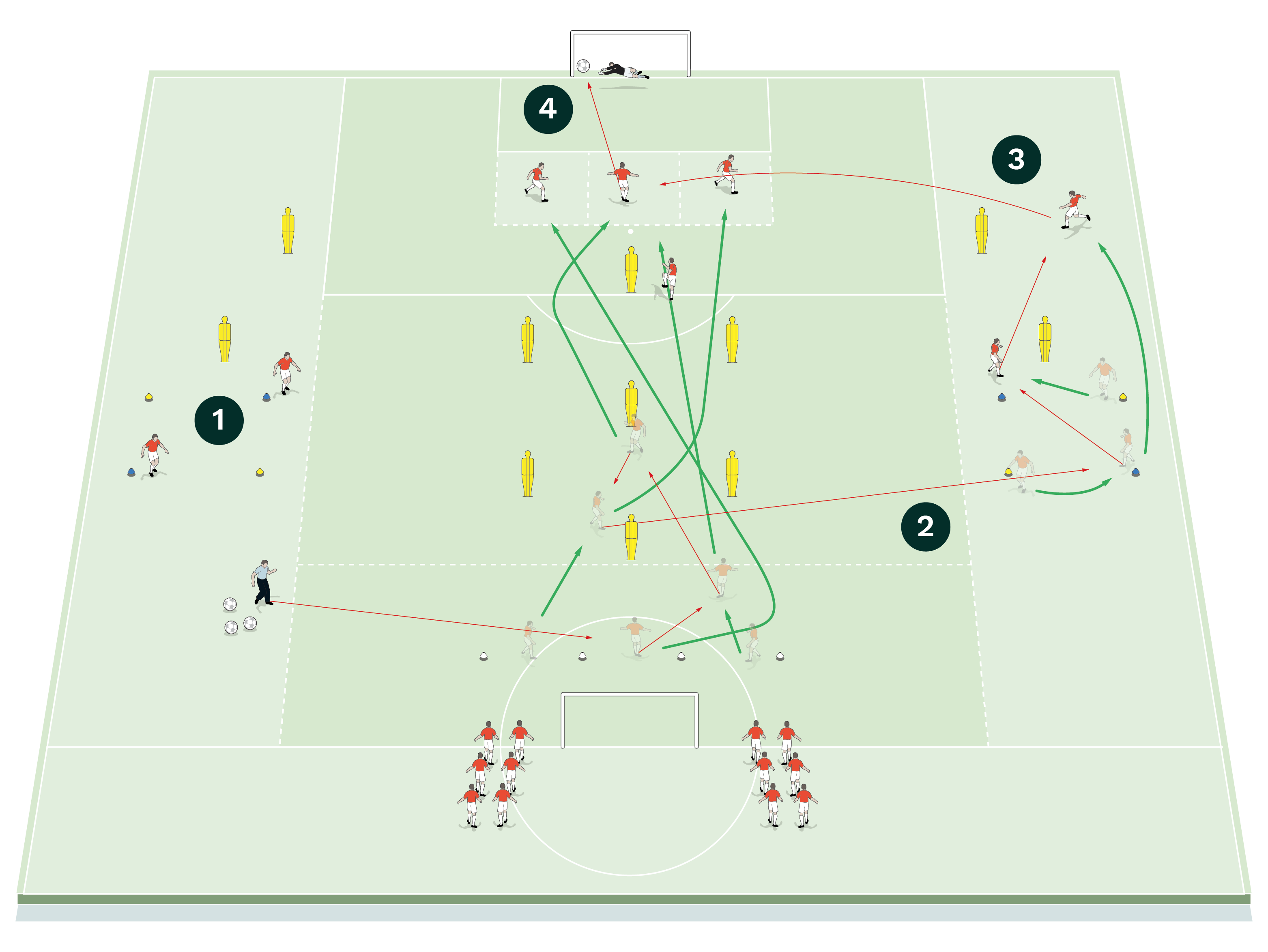
2. The practice now works in one direction. Play starts as before and a pass is played into the striker, who lays the ball off for the next pass to be played out to a wide player
3. The full back and winger combine with each other to play through or around the two wide mannequins to produce a crossing opportunity
4. The three attackers must arrive in the second six-yard box to attack the cross, with the fourth attacker positioning themselves on the edge of the penalty box
Once they have rehearsed and understood the required movement, we want to see the passing sequence performed with game intensity. The first player in each wave to reach the opposition penalty area should try to get a shot off and the other two players should follow the ball into the box to pick up any rebounds from the goalkeeper. It’s important that the shot is on target because picking up on rebounds is an important part of this exercise.
Once the ball is dead the three players should join the back of the waiting queues at the end they have just attacked, while a second wave of players steps in to attack in the opposite direction.
To progress the exercise we would add a striker to each end of the central zone and run the same basic attacking patterns. The strikers would take turns to step in from the side to link the attack and keep the forward movement going, laying the ball off to a team mate before spinning into the penalty area and joining the attack, as shown [1b]. The players should choose the right movement and the right pass, at the right time.
To progress the exercise further we would add a full back and a wide forward to each wide channel, with one starting on each of the cones so they are never on the same line. We also add two mannequins to each of the wide channels. The practice now works in one direction and towards one goal, with the aim being to score from a cross.
A second six-yard box is marked out to provide a reference point for the wide players who are crossing the ball. The second six-yard box is also divided into three smaller boxes and the aim for the attackers is to make runs to occupy each of those three boxes (near post, central and far post) when the ball is being delivered into the penalty area from a wide position.
Play starts in the same way as before and when a pass is played into the striker from one of the three attackers, the striker lays the ball off for the next pass to be played wide to either the full back or the winger. The wide players combine with each other to play through or around the two wide mannequins, with the aim of producing a crossing opportunity. The three attackers must then arrive in the second six-yard box to attack the cross, with the fourth attacker positioning themselves on the edge of the penalty box, as shown [1c].
Different types of combinations can be produced in the wide areas between the full backs and wingers, including overlaps, underlaps and wall passes.
The final progression includes a switch of play from one side of the pitch to the other. The winger receives the ball, turns back out and plays back and across to enable the switch of play, as shown [1d]. The attackers must now focus on timing their runs into the box correctly.
“Different types of combinations can be produced in the wide areas between the full backs and wingers, including overlaps and underlaps”
[1d]
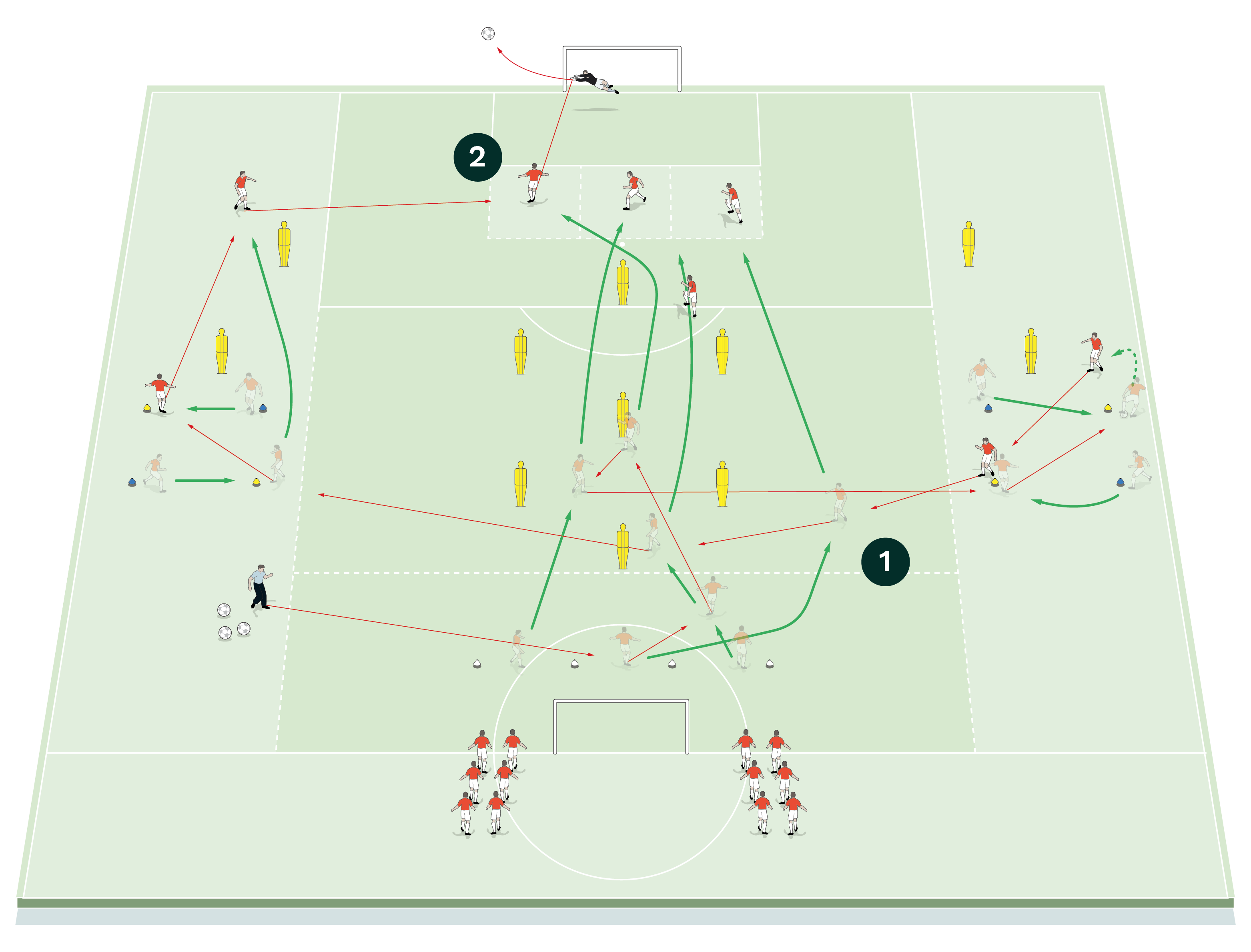
2. The attackers must now focus on timing their runs into the box correctly
11v11 SMALL-SIDED GAME
[2a]
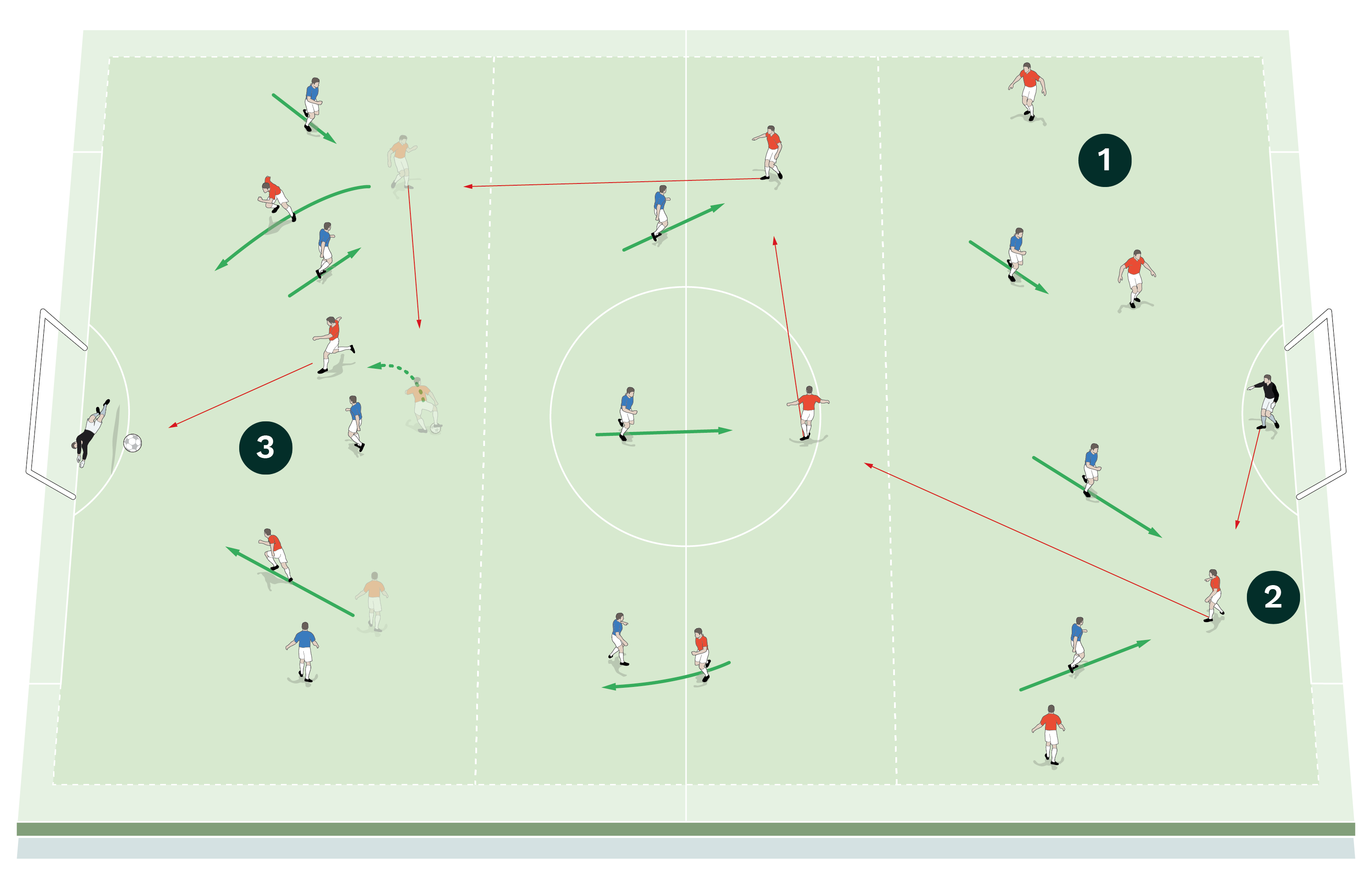
2. Play begins with a pass out from one of the goalkeepers
3. The aim is to play through the thirds to create goal scoring opportunities
[2b]
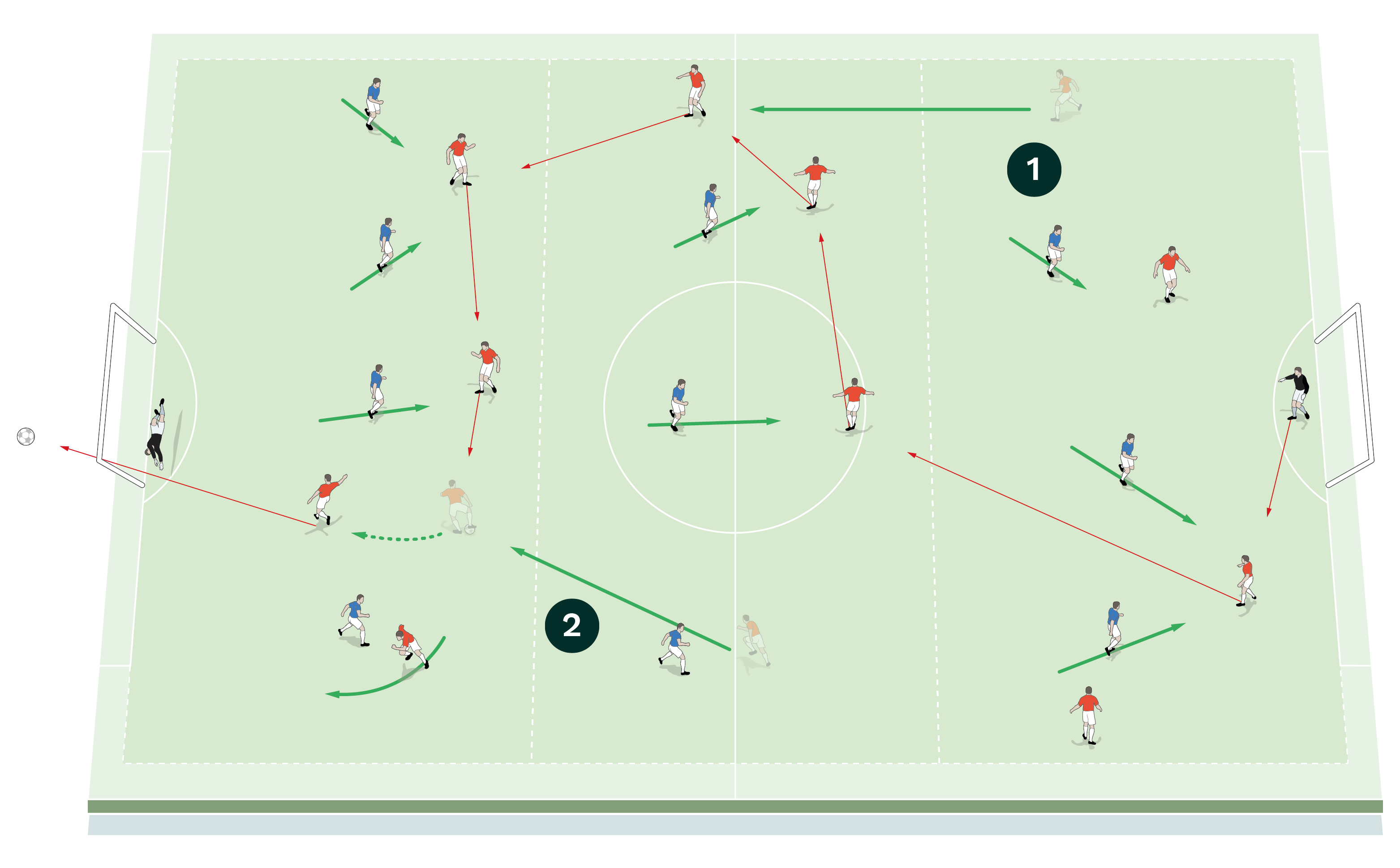
2. When the ball is passed into the attacking third, one midfield player can follow the ball into the attacking zone and join in to create a 4v4 situation
We set up between the penalty areas of a pitch with a full size goal and a goalkeeper at each end. The playing area is divided into three equal-sized zones. We’re using 20 outfield players split into two teams of 11 including goalkeepers. Each team is set up in a 4-3-3 formation, with a 4v3 overload in the defensive third, a 3v3 in the middle third and a 3v4 in the attacking third.
Play begins with a pass out from one of the goalkeepers. In the first block of play the players must stay in their thirds of the pitch and the aim is to play through the thirds to create goal scoring opportunities, as shown [2a].
In the second block of play a defender can now move into the middle third to create a 4v3 overload and when the ball is passed into the attacking third one midfield player can follow the ball into the zone and join in to create a 4v4 situation with the aim of trying to score a goal, as shown [2b].
In the third and final block of play, both full backs can now move into the middle third when their team is in possession. Two players can also move forwards into the attacking third to create a 5v4 situation with the aim of scoring a goal, as shown [2c]. If the defending team wins the ball back, they should counter-attack and take advantage of the 3v2 situation in their attacking third of the pitch.
We run this for three blocks of 10 minutes.
“If the defending team wins the ball , they should counter-attack and take advantage of the 3v2 situation in their attacking third”
[2c]
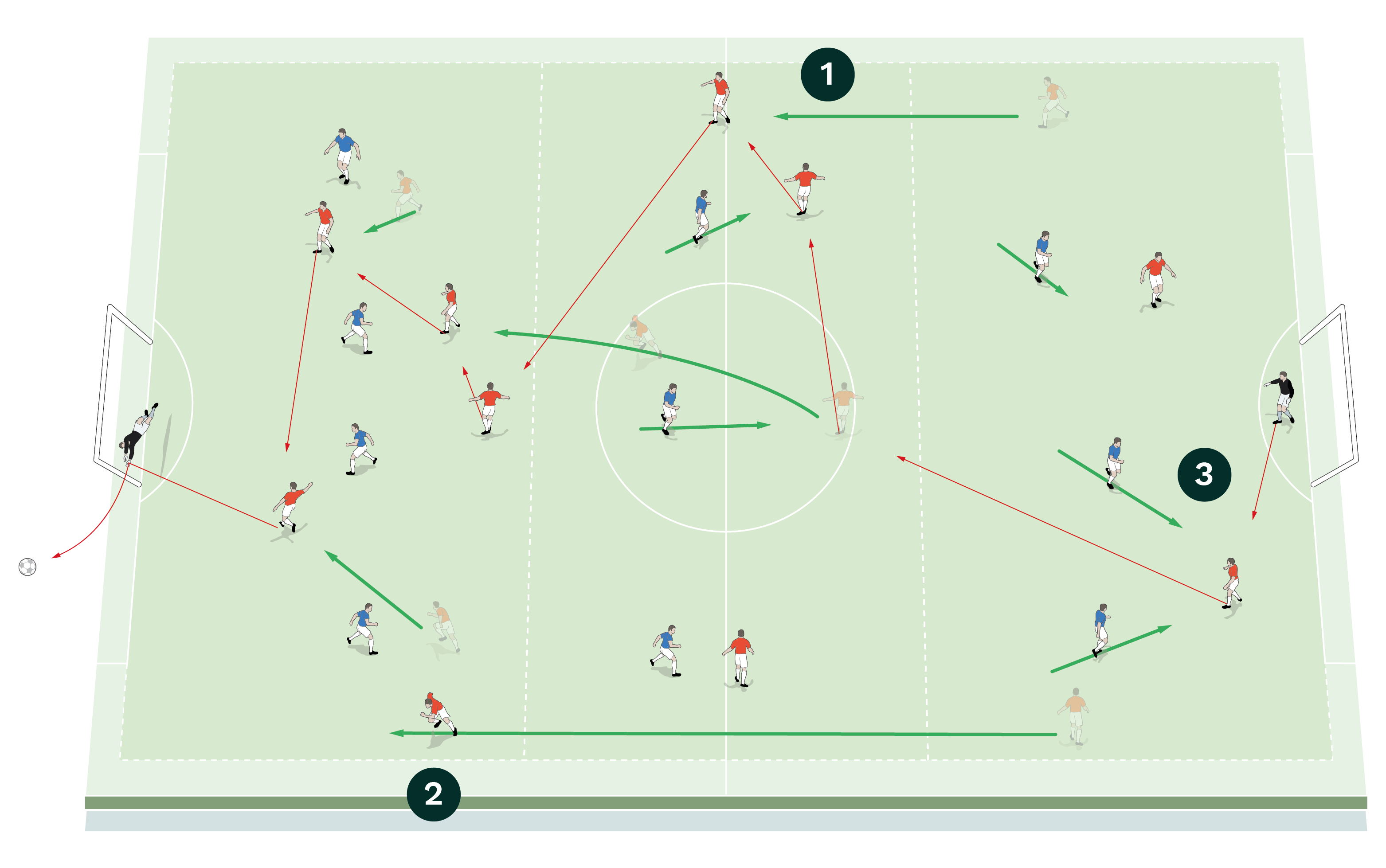
2. Two players can also move forwards into the attacking third to create a 5v4 situation
3. If the defending team wins the ball, they should counter-attack quickly and take advantage of the 3v2 situation in their attacking third of the pitch
COACHING POINTS
What are the key things to look for?
We want to see players understanding the importance of the quality of their passing, their control and their movement, because this session gives players the opportunity to rehearse both shooting on target and scoring from rebounds and second phase chances.
We also want to see wide players delivering accurate crosses into areas such as the second six-yard box, while the forwards should time their runs into the penalty area to meet these crosses.
Above all, we want to see players using good decision making within the team framework.
What are the typical mistakes players might make and how do I avoid them?
Players sometimes display a poor first touch and employ inaccurate passing and lay-offs, while crosses can lead to turnovers of possession too often. We try to overcome these mistakes with coaching Q&A sessions, video analysis and by
asking players for their feedback.
Editor's Picks
Attacking transitions
Deep runs in the final third
Using the goalkeeper in build-up play
Intensive boxes drill with goals
Penetrating the final third
Creating and finishing
My philosophy
Pressing initiation
Compact team movement
Coaches' Testimonials

Alan Pardew

Arsène Wenger

Brendan Rodgers

Carlos Carvalhal

José Mourinho

Jürgen Klopp

Pep Guardiola

Roy Hodgson

Sir Alex Ferguson

Steven Gerrard
Coaches' Testimonials

Gerald Kearney, Downtown Las Vegas Soccer Club

Paul Butler, Florida, USA

Rick Shields, Springboro, USA

Tony Green, Pierrefonds Titans, Quebec, Canada
Join the world's leading coaches and managers and discover for yourself one of the best kept secrets in coaching. No other training tool on the planet is written or read by the calibre of names you’ll find in Elite Soccer.
In a recent survey 92% of subscribers said Elite Soccer makes them more confident, 89% said it makes them a more effective coach and 91% said it makes them more inspired.
Get Monthly Inspiration
All the latest techniques and approaches
Since 2010 Elite Soccer has given subscribers exclusive insight into the training ground practices of the world’s best coaches. Published in partnership with the League Managers Association we have unparalleled access to the leading lights in the English leagues, as well as a host of international managers.
Elite Soccer exclusively features sessions written by the coaches themselves. There are no observed sessions and no sessions “in the style of”, just first-hand advice delivered direct to you from the coach.









